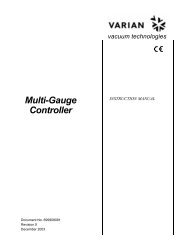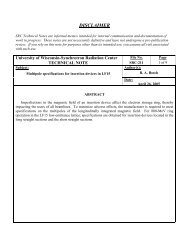SRC Users' Meeting - Synchrotron Radiation Center - University of ...
SRC Users' Meeting - Synchrotron Radiation Center - University of ...
SRC Users' Meeting - Synchrotron Radiation Center - University of ...
Create successful ePaper yourself
Turn your PDF publications into a flip-book with our unique Google optimized e-Paper software.
PHOTOEMISSION STUDIES OF QUANTUM WELL SYSTEMS WITH<br />
VICINAL INTERFACES<br />
D. Ricci, T. Miller, and T.-C. Chiang<br />
Department <strong>of</strong> Physics, <strong>University</strong> <strong>of</strong> Illinois at Urbana-Champaign, 1110 West Green Street,<br />
Urbana, Illinois 61801-3080<br />
Frederick Seitz Materials Research Laboratory, <strong>University</strong> <strong>of</strong> Illinois at Urbana-Champaign,<br />
104 South Goodwin Avenue, Urbana, Illinois 61801-2902<br />
The electronic structures <strong>of</strong> thin metallic films on semiconductor surfaces have been<br />
shown to be pr<strong>of</strong>oundly influenced by the films’ interfaces with the substrate and with the<br />
vacuum. As seen using synchrotron-based angle-resolved photoemission spectroscopy, wellordered<br />
systems grown on low-index faces may exhibit discrete electronic spectra characteristic<br />
<strong>of</strong> quantum wells [1]. In turn, the quantized electronic structure has been observed to impact<br />
various physical properties <strong>of</strong> the film [2]. Vicinal surfaces possess periodic arrangements <strong>of</strong><br />
steps which influence the growth and development <strong>of</strong> adsorbate structures [3], and thus may<br />
produce systems with electronic properties that differ from those formed with substrates oriented<br />
along a high symmetry axis [4]. Currently, we are probing the surface and quantum well states<br />
arising in Ag/vicinal Si(111) and Ag/vicinal Si(001) systems, with an eye towards developing an<br />
understanding <strong>of</strong> their electronic and physical properties. In this regard, comparison to the<br />
existing results from the simpler on-axis systems should prove useful.<br />
This work is supported by the U.S. Department <strong>of</strong> Energy, Division <strong>of</strong> Materials Sciences<br />
(grant DEFG02-91ER45439). We acknowledge the Petroleum Research Fund, administered by<br />
the American Chemical Society, and the U.S. National Science Foundation (grant DMR-02-<br />
03003), for partial support <strong>of</strong> the synchrotron beamline operation and the central facilities <strong>of</strong> the<br />
Frederick Seitz Materials Research Laboratory. The <strong>Synchrotron</strong> <strong>Radiation</strong> <strong>Center</strong> <strong>of</strong> the<br />
<strong>University</strong> <strong>of</strong> Wisconsin-Madison is supported by the U.S. National Science Foundation (grant<br />
DMR-00-84402.).<br />
References:<br />
[1] M. Upton, T. Miller, and T.-C. Chiang, Phys. Rev. B (in press); J. J. Paggel, T. Miller, and<br />
T.-C. Chiang, Science 283, 1709 (1999); T.-C. Chiang, Surf. Sci. Rep. 39, 181 (2000), and<br />
references therein.<br />
[2] J. J. Paggel, C. M. Wei, M. Y. Chou, D.-A. Luh, T. Miller, and T.-C. Chiang, Phys. Rev. B66<br />
233403 (2002); D.-A. Luh, T. Miller, J. J. Paggel, and T.-C. Chiang, Phys. Rev. Lett. 88,<br />
256802 (2002); D.-A. Luh, T. Miller, J. J. Paggel, M. Y. Chou, and T.-C. Chiang, Science,<br />
292 1131 (2001).<br />
[3] E. Hoque, A. Petkova, M. Henzler, Surf. Sci. 515, 312 (2002)<br />
[4] A.P. Shapiro, T. Miller, and T.-C. Chiang, Phys. Rev. B, 38, 1779 (1988)
















